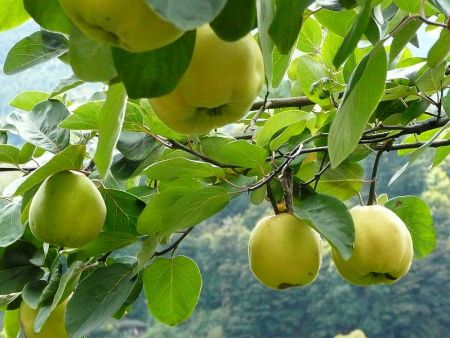In a world of wonderful jams and butters, apple butter might just be the ultimate slow food. Comprised of just a few natural ingredients, and no sugar, the best apple butter cooks most of the day over a low flame, so that the resulting mixture is wonderfully dense and has a rich, caramel-y taste. I’d been wanting to get in touch with my inner Colonial cook and make some, when a friend happened to bring over a bounty of Fuji apples from her backyard tree, and then another friend further inspired me by making amazing dried apples from her tree. (Lucky me!)
Apples were indeed plentiful in Colonial America. Alice Morse Earle’s book, Home Life in Colonial America, lists such dishes as apple-slump (baked apples under a cake topping), apple-crowdy (a turnover-like dessert), and something called apple-mose, along with various types of pies. The book quotes a Swedish parson writing home about the Delaware settlement in 1758:
Apple-pie is used throughout the whole year, and when fresh apples are no longer to be had, dried ones are used. It is the evening meal of children. House-pie .. is made of apples neither peeled nor freed from their cores, and its crust is not broken if a wagon wheel goes over it.
I washed the Fuji apples, appreciating their pretty shapes and colors. In Colonial country homes, it was not uncommon to hold an apple-paring, in which friends and neighbors came to help peel the crop of apples for winter’s dried apples, applesauce and apple butter. The ingredients for apple butter were put into large brass kettles, which were then hung in big, open fireplaces. The finished apple butter would be stored in barrels in the house’s basement. Quince and pear butters were made as well.
My apple butter is extremely easy to make, requiring only the ingredients you see above:
8 cups apples (a cup is approx. 2 small apples)
2 1/2 cups apple cider
1 Tbsp. honey
1 tsp. cinnamon
1/2 tsp. cloves
This recipe yields 2 jars of apple butter and can easily be doubled or tripled. I arrived at it through a combination of various vintage, Amish, and canning books, along with some trial and error.
1. Wash, peel and chop the apples into small pieces.
2. Place the apples into a large pot and cover with the cider.
3. Bring mixture to a boil, then reduce heat to a low simmer.
4. Add remaining ingredients and stir to combine.
5. Simmer on low heat, uncovered for 6 or more hours, or until the mixture cooks down to a paste. You may opt for occasional periods of slightly higher heat, if you find that your mixture remains too watery or if you want to caramelize some of the apples at the bottom of the pot.
This is the “inner Colonial” part — the long, slow cooking process and the fantastic way your house will smell and feel as you do it.
6. Using a wide-mouth funnel, ladle the mixture into jars that have been prepared for canning. (I boil them for 10 minutes in a boiling water canner.)
7. Seal the jars and boil them again, for 10 minutes. Let them sit for a day. (If you follow strict canning guidelines, you can store your apple butter for the future. If you do not, then you’ll want to eat the apple butter within a couple of weeks and store it in the refrigerator.) Please refer to the USDA canning guidelines, downloadable Guide 1, for more information on proper home canning.
Preserves and butters of all kinds make wonderful gifts and spreads, especially one like this, in which there is barely anything to get in the way of the wonderful, fresh, age-old Fall apple taste. Try apple butter on toast or crackers, with cheese, poultry, or even other fruit.
The colonial kitchen above is located at the Shelburne Museum in Shelburne, VT. If you are able to get to this museum, I highly recommend it. It’s like no other — approximately 40 buildings on beautiful grounds house collections of folk art, paintings, quilts, dolls, design, and entire detailed re-creations of such staples of the past as apothecaries, blacksmiths, printing shops, train stations, one-room schoolhouses, and homes of many eras. Look for an upcoming post that details more about the one-of-a-kind Shelburne Museum.
In the meantime, enjoy your butter and fall!
Photos by Susan Sachs Lipman





































